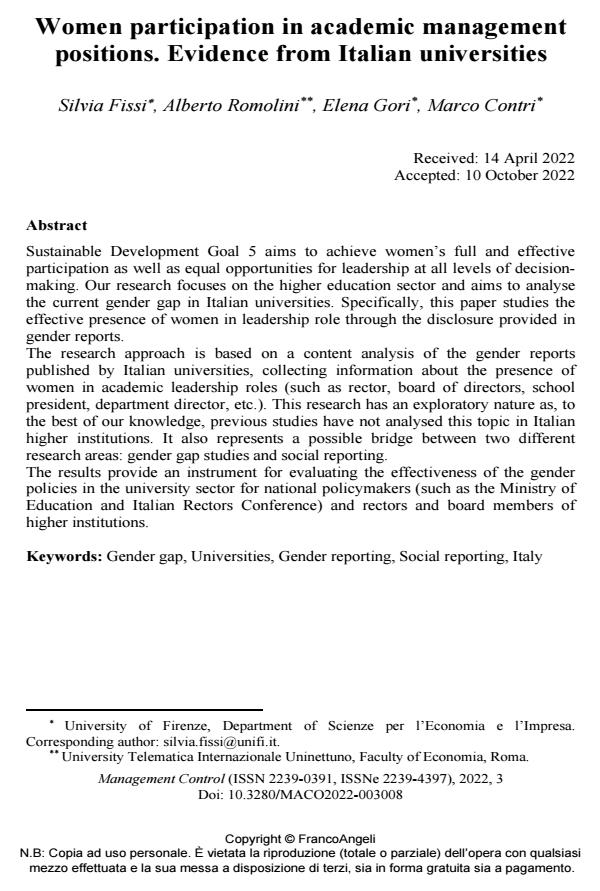Women participation in academic management positions. Evidence from Italian universities
Titolo Rivista MANAGEMENT CONTROL
Autori/Curatori Silvia Fissi, Alberto Romolini, Elena Gori, Marco Contri
Anno di pubblicazione 2022 Fascicolo 2022/3
Lingua Inglese Numero pagine 14 P. 163-176 Dimensione file 309 KB
DOI 10.3280/MACO2022-003008
Il DOI è il codice a barre della proprietà intellettuale: per saperne di più
clicca qui
Qui sotto puoi vedere in anteprima la prima pagina di questo articolo.
Se questo articolo ti interessa, lo puoi acquistare (e scaricare in formato pdf) seguendo le facili indicazioni per acquistare il download credit. Acquista Download Credits per scaricare questo Articolo in formato PDF

FrancoAngeli è membro della Publishers International Linking Association, Inc (PILA)associazione indipendente e non profit per facilitare (attraverso i servizi tecnologici implementati da CrossRef.org) l’accesso degli studiosi ai contenuti digitali nelle pubblicazioni professionali e scientifiche
Sustainable Development Goal 5 aims to achieve women’s full and effective participation as well as equal opportunities for leadership at all levels of decision-making. Our research focuses on the higher education sector and aims to analyse the current gender gap in Italian universities. Specifically, this paper studies the effective presence of women in leadership role through the disclosure provided in gender reports. The research approach is based on a content analysis of the gender reports published by Italian universities, collecting information about the presence of women in academic leadership roles (such as rector, board of directors, school president, department director, etc.). This research has an exploratory nature as, to the best of our knowledge, previous studies have not analysed this topic in Italian higher institutions. It also represents a possible bridge between two different research areas: gender gap studies and social reporting. The results provide an instrument for evaluating the effectiveness of the gender policies in the university sector for national policymakers (such as the Ministry of Education and Italian Rectors Conference) and rectors and board members of higher institutions.
Parole chiave:Gender gap, Universities, Gender reporting, Social reporting, Italy
- The Sociology of Gender in Italy: From Marginal to Mainstream Mariella Nocenzi, Isabella Crespi, in The American Sociologist /2024
DOI: 10.1007/s12108-024-09629-z - Gender Equality and Its Significance for Scientific Research and Innovation Organisations: A Case Study Cinzia Leone, Lina Donnarumma, Vanessa De Luca, in Social Inclusion 10105/2025
DOI: 10.17645/si.10105
Silvia Fissi, Alberto Romolini, Elena Gori, Marco Contri, Women participation in academic management positions. Evidence from Italian universities in "MANAGEMENT CONTROL" 3/2022, pp 163-176, DOI: 10.3280/MACO2022-003008